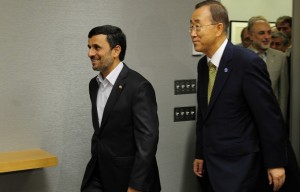 UN Secretary General Ban Ki Moon’s decision to attend the meeting of the Non-Aligned Movement (NAM) – a group of 120 nations allied with neither superpower during the Cold War – this week in Tehran has garnered some criticism.
UN Secretary General Ban Ki Moon’s decision to attend the meeting of the Non-Aligned Movement (NAM) – a group of 120 nations allied with neither superpower during the Cold War – this week in Tehran has garnered some criticism.
The Secretary General will reportedly hold meetings with President Mahmoud Ahmadinejad, Supreme Leader Ayatollah Khameini and a host of other high-level government officials from NAM.
“The secretary-general of the United Nations should not lend credibility to the Iranian regime by attending this summit in Tehran,” said Ronald S. Lauder, President of the World Jewish Conference.
UN spokesman Martin Nesirky said Ban would use this chance to convey to Iranian leaders the concerns and hopes of the international community on myriad issues, including Iran’s nuclear program, terrorism, its human rights record and the crisis in Syria.
The Islamic Republic, who is the acting president in its rotating system of leaders, is hosting this meeting of NAM countries for the first time in its history.
The main criticism coming from the West is that the Secretary General should use this opportunity to send a message to the regime by not attending.
However, Secretary Ban’s visit to Tehran could have a positive effect, especially in light of the soon-to-resume high-level nuclear negotiations led by the P5+1.
In accordance with the Charter of the United Nations, Secretary Ban’s decision can be seen as upholding the requirements of his office, and more importantly, the mission of the United Nations.
With sanctions taking their toll economically, and the nuclear program not missing a step, high-level Western officials have stepped up the campaign to pressure the Iranian regime in recent weeks.
Rather than lending credibility to the regime, Secretary Ban’s trip to Tehran can be seen as one person’s attempt to illustrate how powerful the diplomatic track can be.


